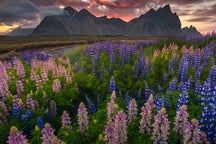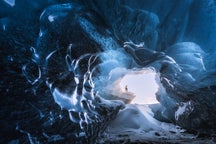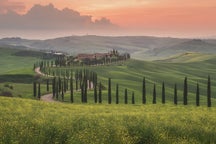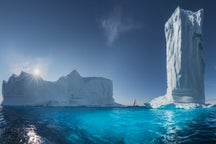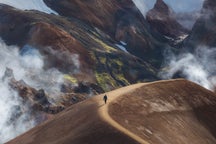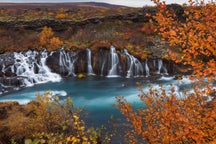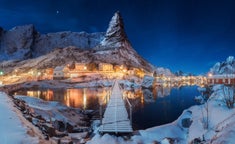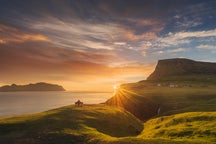
Photography is more than a passion for New Zealand landscape, travel and adventure photographer, Rach Stewart. Having a strong bond with the outdoors has fuelled her desire to explore the world, in search of the hidden beauty that is waiting to be found.
With an impressive client list behind her including Canon New Zealand, National Geographic and Manfrotto, this intrepid explorer is talented, business-minded and above all, down-to-earth. This month, we were lucky enough to chat with Rach about how she got her start in photography, the intricacies of her work, what she has planned for her photography in the future, as well as her thoughts on how photographers can contribute to the preservation of nature for generations to come.
- Check out this New Zealand Spring Photo Workshop
- Find out How to Use Balance for Better Compositions in Photography
- Discover this Interview with William Patino
Hello Rach! Thanks for joining us. For people who may not be familiar with you and your work, how would you describe yourself and the type of work you do with your photography? Where did it all begin?
Thanks for having me! It’s an honour.
I would describe myself as someone who loves to be immersed in nature .. in any shape or form, and capturing those moments in a creative way is where I express myself the most. I was very lucky to have grown up in a creative family where both my parents were ballet dancers .. and so anything to do with the Arts was always encouraged from a very young age. Photography came to me later in life, my two main loves were art and music when I was growing up and a teenager.
Landscapes speak to me and that is where my love for photography lies. Most of my images are designed to capture the natural world in creative way, and to show the all important elements that connect human with nature.
Who have been your mentors throughout your journey so far? How have they contributed to how you practice photography today?
I am self-taught and although I feel I have had many mentors and photographers that I aspire to online, I haven’t actually met many in person, so I’ll list all of those who have helped or inspired me along the way even if just visually by their amazing work. I could only hope to one day be half as good as these talented people. They include Erin Babnik, Marco Grassi, Michael Shainblum, Marc Adamus, Christian Schaffer and Emilie Ristevski.
 Fox glacier. Photo by: 'Rach Stewart'.
Fox glacier. Photo by: 'Rach Stewart'.
- See also: Best Cameras for Beginners in 2020
What is your favourite thing about working as a professional landscape photographer? Have there been any challenges that you’ve had to face in your career?
My favourite thing about landscape photography is that you never know what you’re going to get. I leave the house with a vision in mind and often come away with something completely different. I feel lucky that most of the time, I can choose where I want to go and what I want to shoot, and earn a living from the images that come out of these adventures. I love that I can teach others through my workshops how to grow their passion and share my journey along the way.
There have definitely been challenges. Juggling my family life around my work is not easy. It is something I battle with internally a lot.
Declining high paid jobs due to moral conflict. In the end, morals always win but sometimes, letting go of money that will feed your family can leave you wondering .. what if!
Being a creative can be so very challenging. We pour our hearts and souls into our work, and sometimes there are moments of self-doubt that are difficult to push through. Creative ruts are a real thing! But I have found that in the end, nature always delivers with the light at the end of the tunnel and this is why I owe so much to our natural world.
The world is full of incredibly beautiful locations. How do you decide when and where to travel?
It sure is! Aren’t we so lucky.
I will always have a fascination with the natural world and I am forever thankful to have found a way to connect with our surroundings in a creative and artistic way through photography.
My two favourite things are the mountains and the ocean. Combined with that is exploring the unknown. There is a reason famous places are photographed .. they are so stunning. But I find more pleasure in finding the lesser known places, the untouched gems. They are becoming harder and harder to come by, but those spots that require a little more effort to get to are so worth it.
Autumn and winter would have to be my favourite seasons for the mountains due to the snow and the colour, so many of my mountain based photography trips are planned around that.
During the summer, I spend most of the my time at the beach – my home. Floating out on the ocean is one of my favourite things to do.
 Wanaka tree in fog. Photo by: 'Rach Stewart'.
Wanaka tree in fog. Photo by: 'Rach Stewart'.
You’ve done a lot of travelling to many beautiful places and captured some extraordinary landscapes. Do you have a location that you love to return to time and time again for photography? What is it about this place that keeps drawing you back?
I always find myself back at Aoraki Mount Cook National Park – it’s one of those places that truly captures the heart and the urge to return time and time again is always strong. Aoraki is New Zealand’s tallest mountain and is steeped in culture and history. It has taken many lives and once you see it, you'll understand why. It is a place where I feel humbled and in absolute awe with nature. The name 'Aoraki' represents the most sacred of ancestors from whom Ngāi Tahu descend from and the mountain remains between the supernatural and the natural world.
- See also: Travel Photography Explained
What kind of work goes into the construction of your photographs? Do you find it difficult to maintain photographic reality through the fine art process?
I have found that my use of neutral density filters creates a dreamy or otherworldly effect to the images I take, yet the scene is always reality and what nature has provided. Photographically, I am only capturing what has been presented to me. The long exposure of the image is where creatively, the boundaries can be stretched without using any Photoshop or post-processing effects. Because this is my style, I feel the reality of the scene and image is always the strong point and viewers can always take that away with them.
 Mackenzie. Photo by: 'Rach Stewart'.
Mackenzie. Photo by: 'Rach Stewart'.
Describe the technical workflow that you do in post-production. How do you utilise software to distil emotion and meaning in your photographs?
I try to create all emotion and creativity in camera. I am always on the search to find a stand-out composition showing humans interacting in the natural world and how to resonate that sense of wonder felt when surrounded by such incredible landscape.
I use both Photoshop and Lightroom in post-processing. Usually, this involves correcting colours and tone, sharpness, removing any spots and blemishes, dodging and burning – generally tidying up the image. I usually have a vision of how I want it to look, so I try to arrange colours and everything else to suit my style, without changing reality too much.
What thoughts about nature would you like people to come away with after they look at your photos?
That it deserves the utmost respect .. that we are nothing without it. Nature provides us with so much. Mentally, physically, emotionally .. as human beings, we cannot survive without the natural world.
If an image of mine encourages someone to go outside and be with nature, then that is the best thing I can ever wish for.
 Milford Sound. Photo by: 'Rach Stewart'.
Milford Sound. Photo by: 'Rach Stewart'.
Tell us a bit about your photography workshops in New Zealand. Who are these workshops targeted at and what can people hope to achieve by joining these tours? Do you run photography workshops in any other part of the world?
Pure Photo Adventures is the brainchild of three great friends who happen to be photographers and passionately love landscapes and the outdoors. Approximately 3 years ago, we decided that we wanted to teach people what we knew about photography while showing off our beautiful country at the same time. It's been a huge success so far!
Our tours are designed to take participants on a fun-filled adventure, with like-minded people, through some of the most amazing and iconic scenery New Zealand has to offer. Our emphasis is very much on the in-the-field learning, but that’s not to say we don’t cover the classroom stuff too. All our tours include, at minimum, a filter training session, a Lightroom editing session and a photography tips manual. We cater for all levels, from those just starting their photography journey right through to experienced photographers who just want to brush up on some skills or perhaps simply want to come on an adventure.
We have a diverse range of options covering all the best times for landscape photography and catering for every budget. Our itineraries are planned down to the tiniest level of detail so we can spend the maximum amount of time possible getting participants the most amazing images possible!
Aside from teaching, how else do you make an income with photography? What advice do you have for photographers who are trying to get their work seen and to establish a portfolio? Is there something in particular that is paramount to running a successful photography business?
Before we started our tours, my main photography income came from licensing of images, mostly to larger companies and tourism boards. Magazine editorial images and covers, advertisements and Instagram campaigns also make up a large chunk of the income I receive. The tours are my guaranteed income and it definitely make things a lot easier and less stressful.
My advice to those who are wanting a career in photography is to get your work out there and seen on social media platforms and the web. Create a website with good SEO, be seen on Google. Reach out to companies who share the same values as yourself and offer them something that they can’t get elsewhere. Stay fresh, but don’t lose the essence of your work amongst all the hype. It's very easy to get caught up with what’s on trend .. or what you think you should be creating because everyone else is. Your work is stand-out for a reason and people want it for that reason .. just try to remember that.
 Mt Cook. Photo by: 'Rach Stewart'.
Mt Cook. Photo by: 'Rach Stewart'.
Where do you go for inspiration when you reach a creative plateau?
I try to get myself out in nature, even if it’s to a favourite spot I’ve already visited. You never know what the weather might do or what curveballs nature might throw at you .. nothing ever looks the same time and time again.
For creative inspiration from home, I go to Instagram or search Google. There are so many incredible artists out there on these platforms and in so many different genres. Words, photos, brush strokes, moves, music .. it’s endless.
Art galleries are also very inspiring to me, there’s nothing like a painted artwork to start start stirring creative thoughts in the brain.
- See also: 13 Amazing Summer Photography Ideas
In this highly visual era, what impact can landscape photography have upon people? Do you think it can be used as a medium to effect any kind of change?
I think landscape photography has a great way of connecting people with nature and it could certainly be used in many mediums to positively promote change. We all know the impact humans have had on our natural world and there is strong movement to save what is left and reverse the damage done. We need to start living more sustainably.
Landscape photography is also emotional .. it can spark a memory, a thought, a moment in time .. that in itself can bring viewers joy and reflection, and urge someone to make small but positive changes in the way they live their life.
Landscape photography is a very powerful marketing tool for those reasons.
 Twizel. Photo by: 'Rach Stewart'.
Twizel. Photo by: 'Rach Stewart'.
- See also: Ultimate Guide to Landscape Photography
How can photographers travel and photograph landscapes whilst making sure that they’re not having a negative impact on the environment they’re shooting in?
This is such a good question. We all have a responsibility to look after the environment, especially those of us in the public eye and on social media.
To me .. one of the most important things to do is your research, follow the local and cultural rules pertaining to each location. It’s not ok to break the rules … to culturally offend … to cut corners just to get the shot. Many incredible places have been ruined because of human activity, especially since social media came along. We need to be seen as setting a good example so that others will follow.
To stop the geotagging .. this is another thing we can do to help save these locations from becoming overcrowded and damaging the environment. There really is no need to geotag a location, especially one that has yet to be exposed to social media. Let people do their own research on how to get to places. If you are going to directly geotag a place, explain the rules and any cultural and environmental sensitivities around it.
Pack in and pack out .. don’t leave anything behind like trash. Leave it as if no human has ever visited. Take only photographs, leave only footprints.
Treat nature as it were a living breathing creature that is delicate and deserves the utmost care. We are nothing without it.
Do you think nature photographers have a responsibility to educate the public on conservation issues? How can they do this effectively with their photography?
Absolutely. I think we all have a responsibility to some degree, but definitely those in the public eye who are working with nature and promoting it as such.
The key to educating is to be authentic.
 Lake Matheson. Photo by: 'Rach Stewart'.
Lake Matheson. Photo by: 'Rach Stewart'.
Finally, tell us a little bit about what you’re currently working on and what’s in store for you in the coming year.
I’ve just had a good break over the summer here in New Zealand. I haven’t picked up the camera a lot, but I’m just about ready to get back into it.
My first job for the year is a commercial shoot for an Australian company shooting in the South Island, then after that we will embark on our Autumn Photo Workshop at Pure Photo Adventures NZ. A couple more workshops after that, there is a trip to Tonga, but I am also hoping to get to another international destination this year for personal photography.
The rest of the work, I just take it as it comes!
Personally I’d like to focus more on my underwater photography and hopefully I will have time to do that in between work and life.
Thanks so much for having me!
For more information on Rach Stewart's work, you can visit her website or find her on Facebook and Instagram.
Follow in Rach's footsteps as a landscape photographer! Check out our range of international photo tours and photography workshops.





